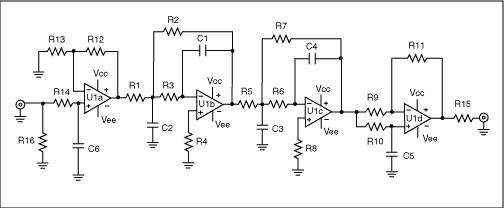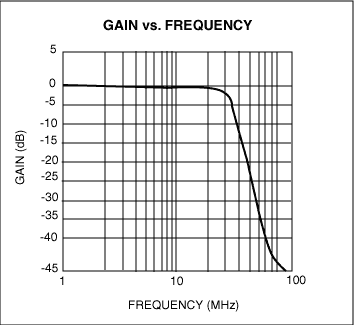

HDTV重建滤波器降低成本和提高性能-Active HDTV
AD技术
描述
In order to preserve the quality of HDTV and progressive DVD video, a bank of three (RGB/YPbPr), 5-pole reconstruction filters are used to set the 30MHz bandwidth and to provide the >40dB selectivity required by EIA770-3.
Historically these filters have been passive L-C types. Because of the steep selectivity of the filter, they require group-delay compensation. They also require gain to drive the back-terminated output and isolate the filter and DAC from the load. Because of the difficulty, custom parts, and tuning required, L-C filters used for these applications are usually purchased at significant cost, which is further burdened by the cost of buffering.
The active-reconstruction filter shown is a lower cost alternative. It uses R-C components, and provides a 30MHz bandwidth with >40dB rejection at 74.25MHz, as well as group-delay compensation and buffering using a single MAX4383 quad op amp. The improved tolerance of capacitors (1% to 2%) vs. inductors (5% to 10%) removes the need for production tuning, although initial component selection is required to account for the parasitic components of the PCB. The circuit shown uses dual supplies, but the MAX4383 can use a single supply with appropriate biasing.
The filter itself is a Rauch, or multiple-feedback realization of a 5-pole, modified Butterworth characteristic using one first-order +6dB gain stage and two 2nd-order unity-gain stages. The final stage is a first -order group-delay compensator, which drives the back-terminated 75 load to an overall unity gain. There are three sensitive points in the circuit: R14, which controls the real pole, C1 and C4, which control the high-frequency poles, and C5, which sets the GD compensation.
R16 and a connector are provided at the input, in place of the DAC load, for measurement purposes. The DAC load resistance is typically 35 to 40, on which the values of R14 and R16 are based. In some MPEG decoders, this may be as high as 150 to 160. To accommodate different DAC load resistors, adjust the value of the R14, C6 product accordingly. The values of C1 and C4 are small with respect to the PCBfs parasitic capacity, and reflect a two-sided PCB on FR-4 with 1/2oz, 3/16in-thick copper with a ground plane around the op-amp pins. C5 adjusts the GD compensation. In laying out this circuit, it is best to adjust the values of C1 and C4 for bandwidth before adjusting C5 for GD-variation compensation. A fully configured PCB is available.
Schematic of Filter
Figure 1. A 5-Pole active filter for HDTV and progressive DVD-reconstruction applications.
Component List
| Designation | Qty. | Description |
| C1, C4 | 1 | 3.3pF, 50V C0G, ±0.25pF ceramic capacitor (0603)TDK C1608COG1H3R3CT |
| C2 | 1 | 68pF, 50V G0G, 5% ceramic capacitor (0603)Murata GRM11885C1H680J or TDK C1608C0G1H680JT |
| C3 | 1 | 27pF, 50 C0G, 5% ceramic capacitor (0603)Murata GRM1885C1H270J or TDK C1608C0G1H270JT |
| C5 | 1 | 33pF, 50V C0G, 5% ceramic capacitor (0603)Taiyo Yuden UMK107CG330JZ or TDK C1608C0G1H330JT |
| C6 | 1 | 100pF, 50V C0G, 5% ceramic capacitor (0603)Murata GRM1885C1H101JTDK C1608C0G1H101JT |
| C7, C9 | 2 | 10µF, 6.3V X5R, 20% ceramic capacitor (0805)Taiyo Yuden JMK212BJ106MG or TDK C2012X5R0J106M |
| C8, C10 | 2 | 0.1µF, 25V X7R, 10% ceramic capacitor (0603)TDK C1608X7R1E104K |
| R1, R2, R4, R5, R7-R13 | 11 | 210, 1% resistor (0805) |
| R3 | 1 | 100, 1% resistor (0805) |
| R6 | 1 | 121, 1% resistor (0805) |
| R14, R15, R16 | 3 | 75, 1% resistor (0805) |
| R17 | 0 | Not installed, resistor (0805) |
| U1 | 1 | MAX4383EUP (14-pin TSSOP) |
| INPUT, OUTPUT | 2 | BNC connectors |
| None | 1 | MAX4383 PC board |
Typical Applications Circuit
Figure 2.
Gain vs. Frequency
Figure 3.
1. MAX4383 EV kit
- 相关推荐
- 热点推荐
- HDTV
-
THS7316 具有 5 阶滤波器和 6dB 增益的 3 通道 HDTV 视频放大器技术手册2025-05-21 856
-
租用站群服务器时如何降低成本?2025-01-22 592
-
降低成本城域网2024-10-12 275
-
更低成本且性能提升的HDTV有源重建滤波器2023-06-12 1451
-
通过集成式有源EMI滤波器降低EMI并缩小电源尺寸的方法2022-11-04 839
-
ADV7802:12位,SDTV/HDTV 3D COM滤波器,视频解码器,和图形Digitizer数据Sheet2021-04-24 753
-
LTC1564:数字调谐抗锯齿/重建滤波器简化了高性能DSP设计2019-08-07 1505
-
电机企业降低成本的误区2018-10-11 2285
-
HDTV中高性能模拟信号处理的一些问题和设计考虑2017-12-06 2035
-
高性能低成本电子秤的参考设计2011-01-02 2172
-
STi7111设计的低成本HDTV卫星STB译码技术2010-09-29 1423
-
ADA4424-6是一个高性能影像重建滤波器2010-01-25 876
-
低成本、30MHz、三通道HDTV重建滤波器2009-04-25 1124
-
在高清晰LCD HDTV 中使用Cyclone III FPGA2008-10-16 5077
全部0条评论

快来发表一下你的评论吧 !

